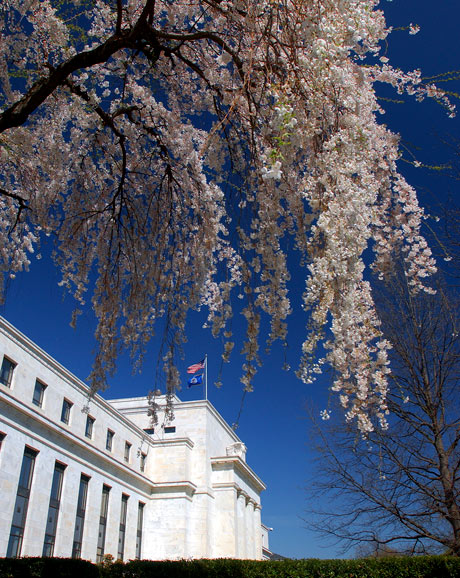Understanding the Role of Monetary Policy in the Economy
In this blog, we’ve previously sought to explain differences between fiscal and monetary policy. Briefly:
Monetary policy is typically the responsibility of a central bank. In the U.S., that’s the Federal Reserve—more specifically, the Federal Open Market Committee (FOMC). The FOMC includes the Fed Board of Governors, who are presidential appointees confirmed by the Senate; the New York Fed president; and regional Reserve bank presidents who serve as voting FOMC members on a rotating basis. Monetary policy refers to actions the FOMC takes to pursue its dual mandate of price stability and maximum sustainable employment.
Fiscal policy, meanwhile, refers to revenue collection and spending decisions made by a government: What is taxed and by how much, where appropriations go, which agencies and programs are prioritized and to what extent, etc. At a federal level, fiscal decisions are made by Congress and the administration. The Federal Reserve is not involved in setting fiscal policy.
Policy Actions amid Coronavirus
Historically, both fiscal and monetary policies have played a role when an economic shock occurs. The novel coronavirus, in addition to having devastating impacts on public health, is now affecting the global economy as well.

Amid many other news stories you’ve seen about COVID-19, you likely heard that the Fed has recently taken multiple actions (through the FOMC and the Fed Board of Governors) in accordance with its mandate.
These actions included, on March 15, reducing the target range for the federal funds rate to zero to .25%. The Fed also acted to provide liquidity in the financial system, to support the flow of credit to households and businesses, and to increase its holdings of Treasury and mortgage-backed securities.
You can see the latest Federal Reserve actions and statements summarized on the Board of Governors’ COVID-19 page.
In this article, we’ll explain more about the Fed, monetary policy and a central bank’s role. To help, I consulted economist David Wheelock, who serves as St. Louis Fed deputy director of Research. He has studied Federal Reserve history going back to its establishment in 1913.
Q: To what extent can monetary policy influence the broader economy?
Wheelock: That's a very good and important question.
Fundamentally, monetary policy can influence the price level—the rate of inflation, the aggregate price level in an economy. And it is appropriate to provide a more expansionary monetary policy when there's evidence that inflation is falling or will fall below the desirable level.
In the Fed’s case, we target a 2% rate of inflation. For example, recently there was evidence in the Treasury market that expected inflation had fallen. In circumstances like that, an easing of monetary policy is an attempt to stimulate the economy in such a way as to help bring the inflation rate and expected inflation back to target.
Again, in the long run, monetary policy only really affects the inflation rate, the price level. But in the short run, it can influence the “real” side of the economy as well, and therefore have an influence on employment and GDP growth and so forth.
And so, in an event where it seems that the economy may be weakening or might slow down—particularly in context where inflation expectations are going down—policymakers may recalibrate monetary policy to a more accommodative or expansionary level in order to cushion that decline, or hopefully give it a boost back to the Fed’s legislated goals of price stability and maximum sustainable employment.
By the same token, if you see signs of overheating—inflation rising, maybe financial speculation running away such that it might cause problems in the economy down the road—it would be appropriate to calibrate monetary policy to a tighter stance, to try to resist that.
Q: How can adjusting interest rates make an impact on the economy?
Wheelock: In the United States, the Federal Reserve targets the federal funds rate, and that is the primary tool that the Fed uses to implement monetary policy. This is a market-determined rate; it is determined by the supply and demand for federal funds—essentially, the deposits that banks have with the Federal Reserve—in the overnight market.
The Federal Reserve has an objective, or a target, for this market-determined rate. It uses other administered rates, such as interest on excess reserves, in order to try to encourage the fed funds rate to get as close to the target as possible.
If the federal funds rate is falling, then in some sense, the cost of funds for banks is falling. So banks are able to pass that along to borrowers in the form of lower interest rates on car loans or mortgage loans, and so forth.
It’s important to note, though, that short-term rates—such as rates on short-term Treasury bills and securities, or money market rates—are more closely tied to the federal funds rate than the rates on longer-term loans.
Q: Do interest rates affect employment?
Wheelock: Regarding employment, the classic textbook argument is that if a central bank wants to try to boost employment, it uses its tools to try to encourage lower interest rates, which will stimulate borrowing. That will enable more consumers to buy cars and houses, and it will encourage firms to invest in new plants and equipment or to build up their inventories. In so doing, they’ll likely hire workers, which will tend to lower the unemployment rate.
That’s the textbook Econ 101 version. In practice, it’s not quite so neat and simple, but that’s the basic idea.
So while there may be ways a central bank can help boost employment in the short run, in the long run, monetary policy is only going to affect the inflation rate. Unemployment and things in the real economy are going to be determined by the technology, the amount of labor, even the weather—things that are not under the direct influence of monetary policy.
Q: Beyond interest rates, what tools do central banks have?
Wheelock: As we saw for a long time after the 2007-09 financial crisis, when the federal funds rate was effectively at zero, the Fed employed so-called unconventional policy tools.
This included forward guidance, which involves giving guidance to the public about where the Fed expects monetary policy to be over time—for example, how long it expects to keep the federal funds rate at zero. By communicating like that, the Fed can have an influence on longer-term interest rates in the economy, thereby having an effect even when it is not currently adjusting the federal funds rate.
Of course, the Fed has also engaged in the quantitative easing, or QE, programs where it bought large volumes of longer-term government securities and mortgage-backed securities. And there's evidence that those were effective in terms of influencing markets and the economy. Quantitative easing is a type of open market operation, an injection of reserves into the banking system that can influence the supply of credit.
As the March 15 FOMC statement said, the Committee will keep monitoring the implications of incoming information for the economic outlook, including information related to public health, and it will use its tools and act as appropriate to support the economy.
Q: Can you describe the Fed’s role as a “lender of last resort”?
Wheelock: Historically, the main operation of a central bank was to provide a lending facility and serve as a “lender of last resort” to the banking system in the event of a liquidity shortage.
The central bank is there to provide that supply of liquidity.
I would point out that, as the Fed showed during the financial crisis, the discount window can be important if banks are finding a need to borrow reserves or if there is disruption in financial markets such that there's a sudden liquidity shortage or freezing of markets.
In the financial crisis, the Fed came up with a number of programs to try to provide liquidity to specific aspects of financial markets to keep the gears of the financial system well-lubricated, with the goal of keeping the economy going as best we could. For example, the Fed set up a facility to support the commercial paper market. Recently, the Fed recently announced it would establish a new Commercial Paper Funding Facility to support the flow of credit to firms during the coronavirus pandemic.
Q: To what extent can monetary policy assist?
Wheelock: Clearly, there are some limits to what monetary policy can do. This pandemic is, of course, something that public and private health experts are working on diligently. The Fed does not employ doctors or clinicians or biologists, so we're not able to provide support in terms of the real solution: identifying treatments or a vaccine for COVID-19.
Economically, the central bank is not the only game in town, and there are others who have an important role in a situation like this.
But the Fed can to try to cushion the blow and help the economy weather whatever storm this is. As Chairman Powell said at his March 3 press conference, “We can and will do our part … to keep the U.S. economy strong as we meet this challenge.”
Additional Resources
COVID-19: Read a statement from St. Louis Fed President Jim Bullard, and find resources that may be helpful during this unprecedented time.
This blog explains everyday economics and the Fed, while also spotlighting St. Louis Fed people and programs. Views expressed are not necessarily those of the St. Louis Fed or Federal Reserve System.
Email Us


